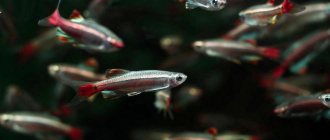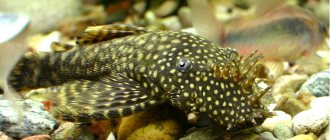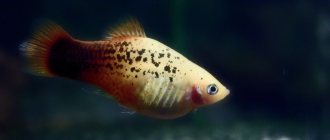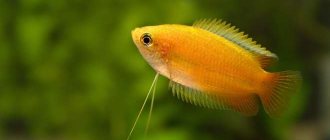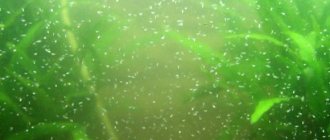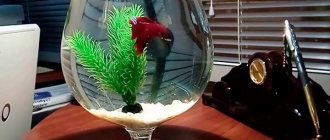The last letter of the letter is “i”
Answer for the question “Threadfish”, 6 letters: gourami
Alternative crossword questions for the word gourami
Swims in an aquarium
Akara's aquarium girlfriend
This fish of the labyrinth family is found in the fresh waters of South and Southeast Asia.
Acara and catfish's girlfriend
Fish from the rivers of South America for the aquarium
Popular aquarium fish
Sister of Akara and Guppy in captivity
Definition of the word gourami in dictionaries
Encyclopedic Dictionary, 1998. The meaning of the word in the dictionary Encyclopedic Dictionary, 1998. fish of the labyrinth family. Length up to 60 cm. The anterior rays of the pelvic fins are elongated into long threads (serve as organs of touch). In the fresh waters of the South. and South-East. Asia. Pond and aquarium fish farming facility.
Great Soviet Encyclopedia Meaning of the word in the dictionary Great Soviet Encyclopedia (Osphronemus goramy), fish of the labyrinthine suborder (Anabantoidei), a group of perciformes. Body length up to 60 cm. The color is bright and beautiful. The pelvic fins have one hard spine and 5 soft rays, the first of which is turned into a long flexible thread that serves.
Examples of the use of the word gourami in literature.
Fire barbs, cardinals, gouramis, macropods, catfish, angelfish and cockerels were fighting in transparent jars.
I really intended to wait for the train and immediately rush off to run errands, but after such a warning, naturally, I stayed with Gurami until late at night.
We threw our worn-out suitcases into the truck and kissed the Gourans, with whom we had become close friends for the rest of our lives.
There were cars parked near the fence: in front of those sitting on the stones, Gurami was slowly walking, his sandals creaking, a tall man with the bearing of a military general.
Geula sighed, flicked Sergun on the nose, and they set off, accompanied by all the Gurs, as well as Lapidus and other volunteers, to the Street of Lilies.
Source: Maxim Moshkov library
Habitat
It is found throughout the basin of the Ganges and Brahmaputra river systems in the territory of modern eastern India, Nepal, Bangladesh and Bhutan.
The habitat is unstable; during the monsoon season (July-September) there is heavy rainfall, which significantly raises the water level in the rivers and changes their hydrochemical composition. Brief information:
- Aquarium volume - from 100 liters.
- Temperature - 15–25°C
- pH value – 5.0–7.5
- Water hardness - soft (1–12 dGH)
- Substrate type - any soft
- Lighting - dim
- Brackish water - no
- Water movement – little or no movement
- The size of the fish is up to 10 cm.
- Food - any food
- Temperament - relatively peaceful
- Keeping in a male/female pair or small group, harem type
Description and structural features
Another name for viviparous gouramis is threadbearers. This is explained by the presence of long fins on their abdomen, which help the fish navigate in the water. The length of adult fish in nature can reach 15 cm, but among the representatives there are also record-breaking species (serpentine gourami), which grow up to 25 cm. In captivity, fish rarely exceed the size of 10 cm.
Thanks to their thread-like fins, gourami received another name - thread-carriers.
Since threadfish in nature live most of their lives in turbid, stagnant water, during evolution they developed an adaptation - an epibranchial organ called a labyrinth. It is this that allows you to swallow air and withstand up to eight hours without water. The labyrinth in the epibranchial cavity allows fish to migrate from one body of water to another.
Representatives of the genus Trichogaster have a laterally flattened body shape. The anal and dorsal fins are pointed and somewhat longer in males. The fins on the abdomen have a length equal to the length of the fish's body. Very often these fins, touching sharp stones, break, but soon grow back. The coloration is very diverse, with males being brighter than females.
Maintenance and care, arrangement of the aquarium
The optimal tank size for keeping one pair of Ctenops nobilis starts from 100 liters. The fish prefer dim light and do not tolerate internal currents well, so the aquarium equipment is adjusted accordingly. Otherwise, they are completely unpretentious and thrive in a wide range of temperatures and pH and dGH values. In the summer, they are even able to live in open ponds in the backyard. The design usually uses thickets of shade-loving plants, including floating ones, a sandy substrate with shelters in the form of driftwood, decorative objects (sunk ships, castles, etc.) or ceramic crusts turned on their sides. Aquarium maintenance comes down to regular cleaning of the soil from organic waste and weekly replacement of part of the water (10–15% of the volume) with fresh water.
History of appearance in Europe
The homeland of representatives of the macropod family (order Perciformes), which includes gourami, is considered to be the water bodies of Southeast Asia. Fish feel good not only in clean rivers and lakes, but they are also found in gutters and even puddles. Nevertheless, for quite a long time it was not possible to introduce gourami into Europe.
The dream of the French scientist Pierre Carbonnier was to breed these fish in France. A large number of attempts to transport it in barrels from Vietnam or Malaysia were unsuccessful. The fact is that at that time all fish were transported on ships in wooden barrels, which were filled to the top with water and carefully closed with a lid. This was necessary so that during transportation on the ship the fish could not jump out of the container.
At that time, the structural features of gourami were not yet known, so the fish died with this method of transportation. Only at the end of the 19th century was it possible to transport them to Europe.
Gourami appeared in Europe only at the end of the 19th century.
One observant European, while in Asia, noticed that fish from time to time float to the surface of the water to inhale air. It was this fact that no one had previously taken into account , as a result of which the fish died. It was decided to fill the barrels only 2/3 with water and not close the lid. This is how it was possible to deliver all the fish to Europe without any losses. Gourami appeared in aquariums only in the winter of 1896, and in Russia another year later.
Water conditions
Temperature: According to seasonal temperature fluctuations in nature and comfortably between 15 – 25 ° C with even greater extremes being tolerated for short periods. In many countries/well insulated homes artificial heating is not required, but if you want to keep it at a constant temperature somewhere in the middle of the range suggested above should suffice. Increasing temperatures may lead to increased aggressive behavior or the fish may even stop feeding.
Conditions of detention
If the aquarist decides to keep gourami fish, the optimal care and maintenance for them should be selected. Since threadworms are medium-sized aquarium fish, the container for keeping them should be at least 40 liters, and the water temperature should be between 23-26 degrees, but its slight fluctuations will not harm the general condition of the gourami. The recommended acidity level should be 6-7 units, and hardness should not exceed 16.
Thread carriers are undemanding to a significant amount of oxygen in the water, so a little aeration will be enough. It should be remembered that once a week it is necessary to replace the water by at least 1/3. Since gourami like to swim in the middle and upper layers of water, it is recommended to cover the top of the aquarium with a lid to prevent the pets from jumping out of it.
Gourami can jump out of the aquarium, so it is worth covering it with a lid.
Feeding the Threadmen
Caring for and maintaining gourami is not difficult. However, novice aquarists who decide to acquire such fish may have difficulty deciding what to feed gourami in the aquarium.
Threadworms are not picky about their choice of food , so dry food is well suited for them. It should be borne in mind that in natural conditions they feed on insects, aquatic plants, as well as mosquito larvae. Therefore, periodically the fish should be introduced to the diet with live food (brine shrimp, daphnia or bloodworms).
Reproduction and breeding
Any novice aquarist can handle breeding gourami at home. To do this, you will need floating aquatic plants - duckweed, hornwort or ricci. You should also make sure that there is no strong current in the aquarium. It is desirable that during the spawning period the water in the container is stagnant, incapable of destroying the foam nest of fish on the surface of the water. The temperature should be in the range of 24−26 degrees.
During the mating season, the color of males becomes brighter, which attracts females. The process of creating a foam nest is interesting. It is built and maintained intact by the male. He does all this by releasing air bubbles from his mouth, which are connected with saliva. It takes several days to build such a nest.
During the breeding season, the male gourami makes a foam nest where the female lays eggs
After this, the male drives the female under the nest, which begins to release eggs. At this moment, the male fertilizes her. Since the eggs are light, they float to the surface, falling into air bubbles, where their further development occurs. The female lays about 200 eggs during one spawning, which lasts 3-4 hours.
The difference between gourami and other aquarium fish is that the father takes care of the offspring. During this period, you cannot feed the male. When the fry appear, you should take care of the water level, which should be no more than 10 cm. Therefore, ideally, it is recommended to breed threadworms in separate aquariums. This amount of water is necessary for small fish to properly form a labyrinth. As for feeding the fry, ciliates or yogurt will serve as food for them. You can also buy special food for gourami fry.
A male gourami cares for the newly born fry.
It will be necessary to monitor the development of the juveniles, as the larger fish begin to eat the smaller ones. Therefore, the only solution to preserve all offspring is to constantly sort the threadworms by size.
The main features of gourami breeding are:
- the selection of a male and a female should occur naturally: it is important that for one male there are 2-3 females, from which he will choose one;
- It is desirable that the age of the individuals be between 8-12 months;
For successful breeding, a male gourami must be at least 8 months old
- during the spawning period, the water in the aquarium should be clean and stagnant, minimal aeration is recommended;
- during the reproduction and development of fry there should be no irritating factors, so the sides of the aquarium can be covered with thick cloth or paper;
- Females can lay eggs without a nest - on the surface of dense thickets of aquatic plants.
Before you start a gourami in your aquarium, you should take care of the living conditions. Any type of threadworm will require a significant amount of dense plants, snags, as well as places for shelter, since the fish have a somewhat timid character. However, you should not forget about the space for the gourami to move freely, so you will need an aquarium of at least medium size.
Breeding/reproduction
This species has well-developed parental instincts; the responsibility of preserving future offspring is assigned to males. The beginning of the courtship period is initiated by the female or alpha female if there are several females in the aquarium. The fish begin to spin in a kind of dance in an almost vertical position with their heads down. Then a small number of eggs and seeds are released alternately, the male takes the fertilized eggs into his mouth. At the end of spawning, which can last several hours, the male takes refuge in a quiet place in the aquarium to bear future offspring. The incubation period lasts from 7 to 20 days, during which time the male refuses food. The fry emerge fully formed and immediately begin to swim in search of food. If there are other species of fish in the aquarium, it is advisable to transplant the juveniles into a separate tank with identical water conditions, this will significantly increase their chances of survival.
Varieties of gourami
The color variation of thread carriers is very large, which allows you to choose a specific type for the aquarium. These can be either pearl, brown or marble in color.
In fact, although the colors of these tropical fish are quite diverse, there are only four types of gourami:
- lunar;
- spotted;
- brown;
- pearl.
The largest among aquarium fishtails is the brown gourami, which in captivity can grow up to 15 cm. The most interesting for aquarists are the spotted fishtails, since this is the species whose representatives can look different (they have white, yellow, honey, blue coloring) .
The maximum length of gourami reaches about 15 cm in some representatives
The most popular among aquarists are the following species and subspecies of gourami:
- Trichogaster leeri. Pearl threaders are silvery-purple in color with silvery spots throughout the body and fins. The length rarely exceeds 10 cm. Males are much larger and brighter than females, and also have a red throat (in females it is orange). Pearl threadworms have a very difficult time adapting to a new habitat, which is reflected in their pale body color.
- Trichogaster microlepis. The moon gourami has a silvery coloration with a blue tint, which gives the fish its name. If we talk about how long gourami live in an aquarium, then these representatives can live up to 7 years. Luna threadworms look very beautiful in an aquarium with dark soil and rich green vegetation. The fish easily get along in the neighborhood with any other representatives.
If the color of the pearl stringworm turns pale, it means the fish is having a hard time getting used to the new environment.
- Trichogaster trichopterus sumatranus (blue). The main feature of the blue threadtail is the body color of the same name, as well as two black spots on each side (one in the center, and the second near the caudal fin). The dorsal, caudal and ventral fins have many small silvery spots that shimmer beautifully against a dark background.
- Trichogaster trichopterus sumatranus (marbled). The marbled threader is a subspecies of the blue gourami and is the result of a genetic mutation. The difference between this fish and its fellow fish is its dark gray body, as well as small light yellow spots on its fins. There are light stripes on the head that are similar in pattern to marble.
Blue and marbled gourami look very impressive against a dark background
- Trichogaster trichopterus sumatranus var. Gold (golden). Both marbled and golden gourami grow no more than 13 cm in length. The fish has a yellow color with an orange-golden tint. There are small blue spots on the fins and gill covers. Golden gouramis are quite shy. These threadworms love to swim in the branches of algae, so it is recommended to plant an aquatic plant with dense shoots in the aquarium so that the fish have a place to hide.
- Helostoma temminckii. Kissing gouramis are especially popular among aquarists. The fish got this name because they make characteristic movements with their mouths during mating games, during aggression, and also during feeding. Among the representatives of this subspecies there are fish of yellow, pink, and also greenish tints. Their fins are usually light green in color. Kissing gouramis love space, so the aquarium should have enough free space and a small number of other fish. If there are a lot of neighbors, then the thread carriers may begin to show aggression, conquering territory.
Golden gouramis love to hide in the thick algae of the aquarium.
- Sphaerichthys osphromenoides. Chocolate gourami has a brown body color with a red tint. A characteristic feature is the silvery stripes that run from the dorsal fin to the abdomen. These fish are considered one of the smallest among the gourami representatives, since the length of adult individuals does not exceed 5 cm.
- Trichopsis vittatus. The main feature of the grunting thread-carrier is several dark stripes along the body. The fins are variegated and have brown-red spots. Fish prefer to swim among the branches of aquatic plants or driftwood.

